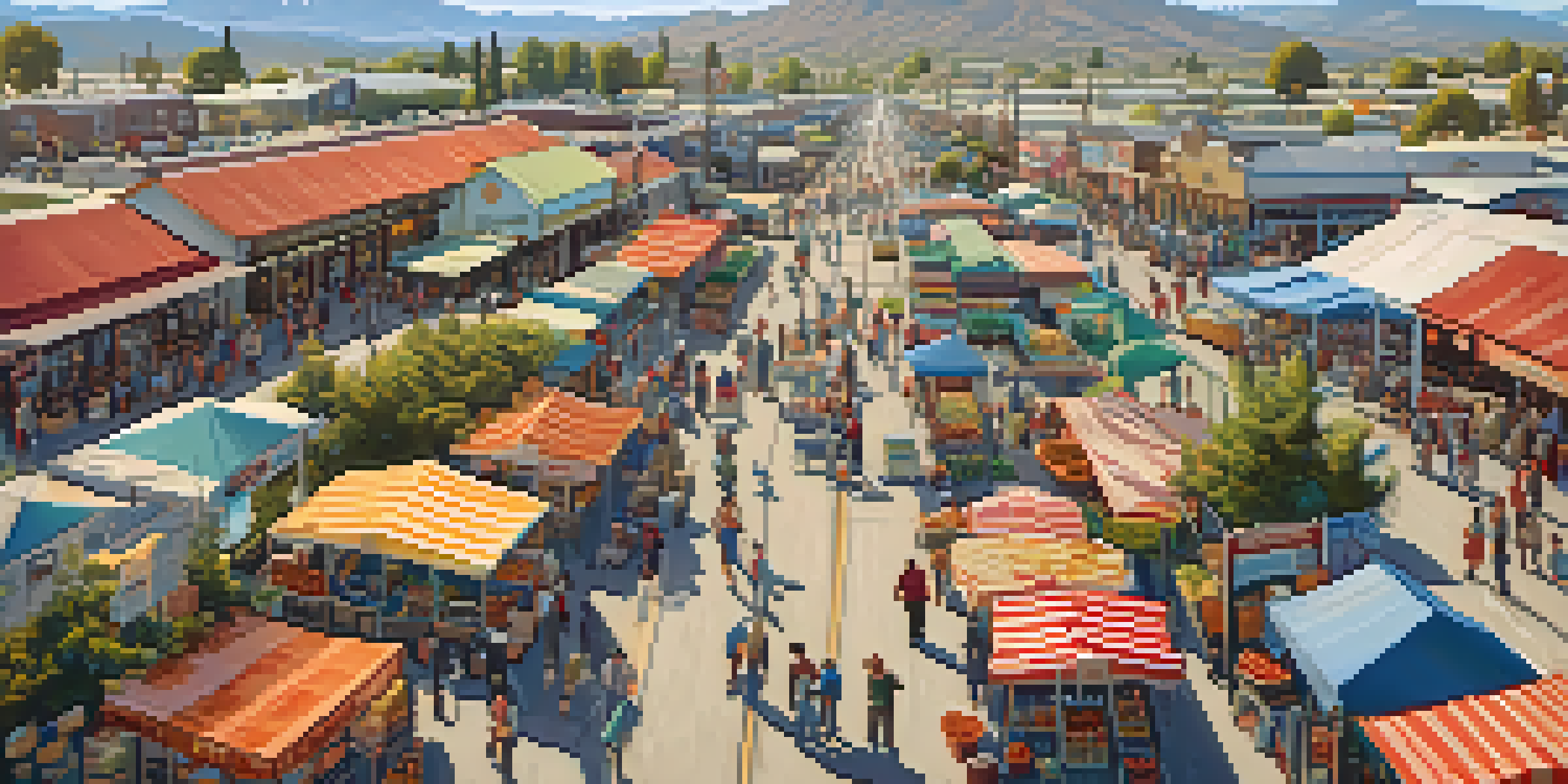Historic Railroads: Impact on California's Economic Growth

The Birth of the Railroad Era in California
In the mid-19th century, California was a land of opportunity, drawing people from all over the world, especially during the Gold Rush. The Central Pacific Railroad, completed in 1869, marked a significant milestone in connecting the East and West coasts. This monumental project not only facilitated the movement of people but also transformed California’s landscape and economy.
The railroad is a great nationalizer. It brings all parts of the country into one vast system of trade and communication.
As the railroads expanded, they opened up remote areas, making them accessible for trade and commerce. Towns and cities began to sprout along the tracks, creating hubs for goods and services. The influx of settlers and businesses fueled an economic boom that would set the stage for California’s growth in the years to come.
Overall, the establishment of railroads laid the groundwork for California's future, forging vital links between agricultural regions and urban markets. This connectivity played a crucial role in shaping both the state’s economy and its vibrant culture.
Connecting Rural and Urban Economies
Railroads served as a lifeline for California's agricultural sector, allowing farmers to transport their goods to urban markets efficiently. The ability to ship produce, dairy, and other products quickly helped farmers maximize profits and expand their operations. This connection not only boosted the agricultural economy but also ensured that urban areas had access to fresh, local food.

Moreover, the railroads facilitated the movement of raw materials to factories and finished goods to consumers, fostering a symbiotic relationship between rural and urban economies. For instance, lumber from the Sierra Nevada was transported to cities for construction, while manufactured goods traveled back to rural areas. This exchange nurtured economic interdependence across the state.
Railroads Transformed California's Economy
The establishment of railroads revolutionized trade and commerce, linking agricultural regions with urban markets and fueling economic growth.
In essence, the railroads bridged the gap between city and countryside, creating a dynamic marketplace that benefited both regions. This interconnectedness laid the foundation for California’s diverse economy that thrives to this day.
Job Creation and Economic Opportunities
The construction and operation of railroads generated thousands of jobs, providing a significant boost to California’s employment landscape. From laborers building the tracks to engineers and conductors operating the trains, the railroad industry created diverse opportunities for workers. This influx of jobs drew people to California, further stimulating economic growth.
The railroads are the arteries of our commerce, and if they are well supplied with blood, the heart of the nation will beat strong.
Additionally, the railroads sparked the growth of supporting industries, such as steel production and manufacturing. As demand for railcars and infrastructure increased, local businesses expanded, creating even more employment opportunities. This cycle of job creation contributed to a thriving economy, attracting skilled labor and entrepreneurs alike.
Ultimately, the railroad industry played a vital role in shaping California's labor market. The diverse job opportunities not only supported families but also fueled innovation and entrepreneurship, laying the groundwork for future economic expansion.
Boosting Tourism and Hospitality Industries
With the advent of railroads, California became more accessible to travelers from across the nation and beyond. Scenic routes through the Sierra Nevada and along the Pacific Coast showcased the state's natural beauty, attracting tourists seeking adventure and relaxation. This surge in travel laid the foundation for a burgeoning tourism industry that would become a pillar of California’s economy.
As cities like San Francisco and Los Angeles grew, so too did the hospitality sector, with hotels, restaurants, and attractions springing up to cater to visitors. Railroads made it easy for tourists to explore California's diverse landscapes, from beaches to mountains, enhancing the overall travel experience. In turn, this influx of visitors injected money into local economies, creating jobs and stimulating growth.
Job Creation Fueled Economic Growth
The railroad industry generated thousands of jobs, attracting a diverse workforce and supporting various supporting industries.
In essence, the railroads not only transported goods but also people, transforming California into a premier travel destination. This shift laid the groundwork for a thriving tourism industry that continues to flourish today.
Impact on Infrastructure Development
The expansion of railroads necessitated the development of infrastructure that would support their operations. This included not only the tracks themselves but also bridges, tunnels, and depots, which required significant investment and resources. As a result, California saw advancements in construction techniques and engineering, leaving a lasting legacy on the state's infrastructure.
Moreover, the railroads spurred the development of roads and highways, as communities sought better access to rail services. This interconnectedness enhanced transportation networks, making it easier for businesses and residents to move goods and travel. The ripple effect of railroad expansion contributed to a more modernized California, setting the stage for future growth.
In summary, the impact of railroads on California's infrastructure was profound, leading to innovations and improvements that shaped the state's development. These advancements not only supported the railroads but also benefited the wider community, fostering economic growth.
Cultural Exchange and Immigration
The railroads played a crucial role in the cultural exchange that characterized California during its growth years. As people from different backgrounds traveled to the state in search of opportunity, they brought with them diverse customs, traditions, and ideas. This melting pot of cultures added richness to California's social fabric, influencing everything from cuisine to art.
Additionally, the railroads facilitated immigration, allowing workers from various countries, including Chinese laborers who played a key role in building the transcontinental railroad, to settle in California. This influx of diverse populations contributed to the state's vibrant communities and economic dynamism. The cultural contributions of these groups have left an indelible mark on California’s identity.
Cultural Exchange Shaped California
Railroads facilitated immigration and cultural exchange, enriching California’s identity and fostering a spirit of collaboration.
Ultimately, the railroads not only connected regions but also people, fostering a spirit of collaboration and innovation. The cultural exchange initiated by this connectivity has helped shape California into the diverse and thriving state it is today.
Challenges and Legacy of Historic Railroads
While the railroads significantly contributed to California's growth, they also brought challenges that the state continues to address today. Issues such as land disputes, environmental degradation, and labor exploitation marred the history of railroad expansion. These challenges serve as reminders of the complexities involved in rapid development and the importance of sustainable practices.
Despite these challenges, the legacy of the railroads remains a pivotal part of California's narrative. They not only transformed the economy but also shaped the state’s cultural and social landscapes. Understanding this history allows us to appreciate the intricate connections between past and present, as well as the lessons learned along the way.

In conclusion, the historic railroads of California are more than just tracks and trains; they represent a transformative era that spurred economic growth and cultural exchange. Reflecting on this legacy helps us navigate the future while honoring the past.